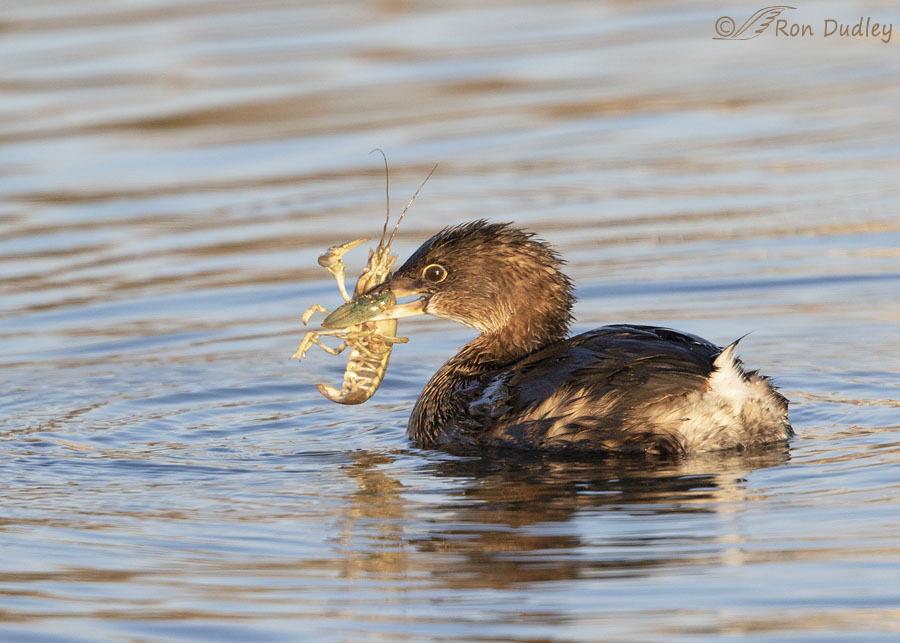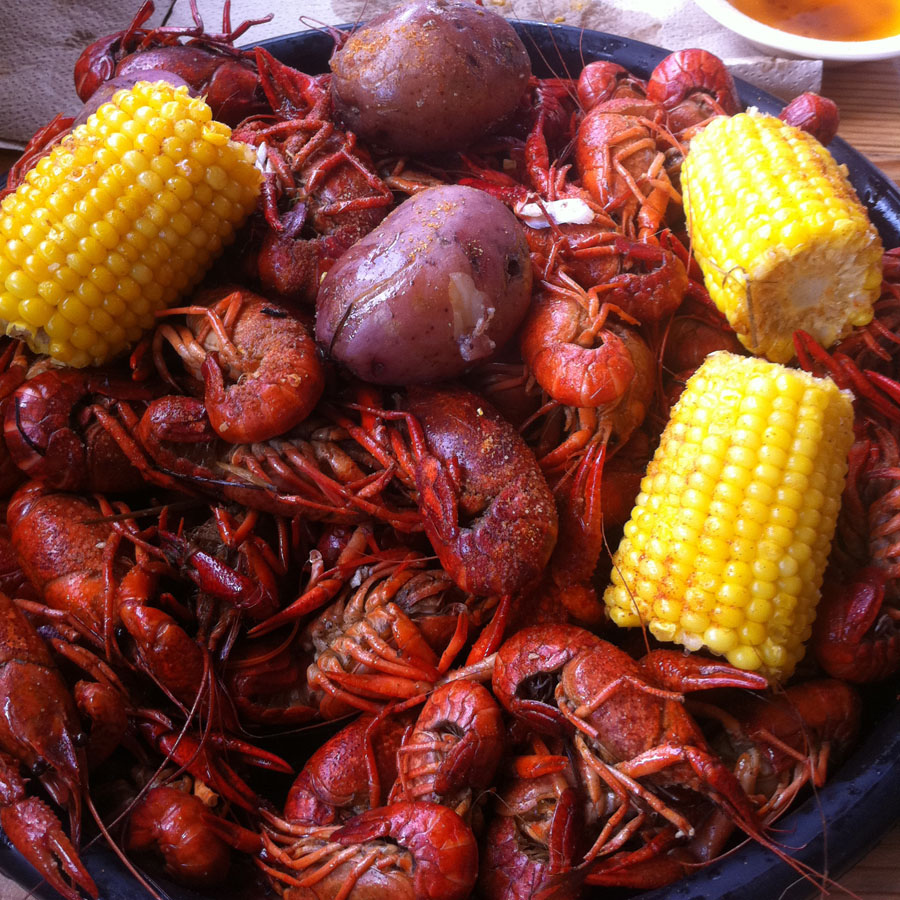A good look at both predator and prey in warm light.

1/1000, f/6.3, ISO 500, Canon 7D Mark II, Canon EF 500mm f/4L IS II USM + EF 1.4 III Extender, not baited, set up or called in
Several weeks ago I was lucky enough to get this Pied-billed Grebe in my viewfinder soon after it caught a fairly large crayfish. It was just before sunset so the light was unusually warm which put a golden glow on both the bird and the crustacean.
I had a lower shooting angle than I can usually get on this species and I was pleased that the grebe didn’t turn away from me as it dismembered the crayfish like they so often do. I think they tend to turn away from photographers while they have prey for two reasons – to allow a quick getaway at a vulnerable moment if necessary and to aggravate the photographer!
Whatever their motivation they almost reliably turn away from photographers when they have prey.
I never know for sure what name to use for these crustaceans when they’re included in my photos because there are so many of them that are commonly used in different regions of North America and elsewhere. My tendency is to call them “crayfish” because that common name is the most clinical and scientifically accurate and I was trained as a biologist. But there are more than 500 species of crayfish in North America and in the South especially they’re a significant part of regional cuisine so a variety of terms for “crayfish” have developed.
The diversity of names for them is astonishing. They include crawfish, crawdads, mudbugs, ditchbugs, swampbugs, yabbys, water dogs and many others. In one ambitious study of American linguistics the Dictionary of American English (DARE) identified more than 40 regionally used common names for crayfish. Talk about confusing!

Crawfish Boil, Creative Commons, Wikipedia, Giovanni Handal
The variety of regional recipes they’re used in is almost as diverse, including but not limited to crawfish boils, crawfish étouffée, fried crawfish, crawfish bisque, crawfish dressing, crawfish pie and crawfish beignets. Here I’ve used “crawfish” in all the recipe names but imagine the variety when some or all of the other names for crayfish are used.
I suppose grebes don’t give a hoot what we call them. To birds crayfish are just a highly nourishing food item with an astonishingly large number of annoying appendages that have to be dealt with before and during the swallowing process,
For many birds crayfish as food must be well worth their inconvenience.
Ron


Looking at that dish of mudbugs makes me miss New Orleans. We lived there for 5 years. “Great place to visit.”
No shrimp or lobster for at least twenty years. I do drool over the thought of a big bowl of kale. Just kidding, I hate kale.
Saw the Black-crowned Night Herons today, although they were roosting/sleeping deep in a tree and not much to see, save for their occipital plume, the mention of which duly impressed my companions; except for one who also follows your blog (and who introduced me to it) and prompted a conversation about you and your blog.
“prompted a conversation about you and your blog.”
Oh to be a fly on the wall…
In my experience roosting/sleeping night herons are closer to the rule than the exception. Unless they’re already in flight so it’s too late to get my lens on them.
I cook shrimp at least once per week – it would be hard to live without them. Crunchy panko-fried shrimp are a favorite.
First off, the first photo is informative in terms of the Pie-billed Grebe diet. And, as usual, I’m very impressed you caught him in the act.
The second photo to me looks like Ridley figured out a good way to dispatch the Aliens once they hatch.
So I assume:
Pie-billed Grebes have gizzards to grind up the digestible from the non-digestible parts.
Either the non-digestive parts come up as pellets or, well, I’m not sure about the alternative method of elimination.
I’m glad that Grebes find them a good source of protein; as for me, boiling an animal and sucking out its innards is something I would do only after imbibing a six pack (or two).
Yup, they have gizzards. And they also throw pellets though I’ve never seen it happen. I’ve read that, unlike many birds that struggle to regurgitate pellets, this species throws them easily and quickly. And presumably often.
I’d love to catch one in the act in a photo one day.
I have to ask you a question, Lyle – do you not eat shrimp? Eating them is almost exactly the same process. Or lobster. I’m drooling now. Dinnertime…
Both shots are fantastic — for different reasons, of course!
Missed the full moon (I double-checked), but the birds here are certainly in a mood! Saw a small bird chasing off a RTHA this morning and then after lunch, DH and I watched some seagulls go at it (one got a little too close to a gentleman and his lady). Then on the way home I saw another large Buteo land right next to the road (wasn’t in a position to check the tail, but had a more tan chest than the usual Red Tails in the neighborhood, so not sure what kind of hawk it was — definitely not a falcon, though).
Sounds like your birds are beginning to feel their oats, ie spring hormones, Marty. Ever up here we’re starting to see a little of it with our coots and blackbirds. And yesterday some of the meadowlarks were singing their spring song already.
That late afternoon light helps make this photograph really special!
The grebe usually turns away from us for the same reason I do when I grab a freshly boiled crawdad: “Mine!”
I grew up learning the same as Arwen. A fresh crayfish is hard to beat to catch a nice largemouth bass for dinner!
I’m a fan of warm light too, Wally. Occasionally it can be just a little too warm for my tastes (especially on a dark bird) but that doesn’t happen often.
They are yabbies here.
I am super impressed at the dexterity with which they remove those irritating appendages. And chuffed that the subject of the day decided you weren’t going after its dinner and didn’t turn away.
I was wondering where they were called yabbies. I’d heard most of the other names but not that one.
In my research I found it interesting that crayfish are found in both Australia and New Zealand but you guys have far fewer species of them than we do.
What an education from your posse this morning ! Between “Louisiana Gal’s” lingo lesson, Judy’s pets, and your classroom survivalist, I’ve new respect for
the ugly little buggers, which are absolutely gorgeous in your last photo– ( and me starting a 24 hour fast this AM for a medical test–thanks a bunch! )
I wish you the best, Kris. That long without solid food is tough. Makes me sympathize with many birds who go that long or longer without it fairly often.
“Aggravate the photographer” I think all our subjects love to do that, or maybe Murphy is responsible.:) You say crayfish and I say crawfish – let’s call the whole thing off. Neat photo Ron. I am always amazed at how the grebes can dismantle those things without the aid of hands and then get them down and digest them. Another remarkable part of nature.
“I am always amazed at how the grebes can dismantle those things without the aid of hands”
Exactly, Everett.
And the dismembering process is so incredibly fast! I never even knew they dismembered crayfish before swallowing the rest of the body until I started photographing them at high shutter speeds so I could actually see what they were doing in my photos.
Louisiana gal here.
Crawfish and crawdads and mudbugs are for eating.
Crayfish are for bait.
Very interesting distinction, Arwen!
Interesting!
LOL! Crawdads (as I know them) do have many names and uses tho as a kid the idea that anyone would eat one was “shocking” as they were temporary “pets”! I see the grebe picked a great place to get hold of it’s dinner in order to avoid injury! Guessing that might be a learned technique…. ;)? Wonderful photo, Ron……..
I see the grebe picked a great place to get hold of it’s dinner in order to avoid injury! Guessing that might be a learned technique…. ;)? Wonderful photo, Ron…….. 
Judy, “he” was holding it that way at least in part because he was about to shake his head violently in order to pull off the pincer and discard it. They have to get the large pincers off before they can swallow the rest of the crayfish whole.
I used to keep a crayfish as a pet in my classroom. One time he (it was a male, sexes are easy to ID) crawled up the air hose to my aquarium filter and escaped. I found him the following morning on the floor all the way across my large classroom and even though he was dry and had obviously been there for a long time he was still alive! I put him back in the aquarium and had him for a long time after that.
The advantage they have over most fish in that situation is their carapace which helps to keep their gills from drying out.
Tough little buggers…
That pincer would have to go in order to swallow it whole! I was thinking perhaps they “cracked them” to get the inside…always something to learn….

They were pretty good escape artists as I remember…..
I’ve never seen one go back and eat the discarded pincers, or even try to find them. Not saying it doesn’t occasionally happen though. After all, some people eat the meat in those tiny (to us) pincers…